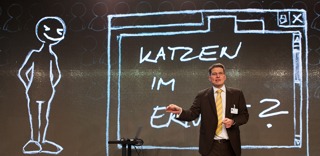Advice from the TED experts – How to give a Killer Presentation
| Date: 4th July 2013 |
| Event: Presentations |
| Technology: Graphic Design, Presentation, Touch Screen, Video Wall |
Chris Anderson of TED on why storytelling is so important in presentations, why it helps to learn your speach by heart, and how multimedia can improve your body language.
Nobody in the world is more skilled in giving high-end presentations that have educational and entertaining value than the folks from TED. Following their motto – Ideas worth sharing – we would like to share an article by Chris Anderson, curator at TED, that was published in the Harvard Business Review on a topic that surely haunts every speaker in the world: How to give a killer presentation.
Framing a story
The number one goal for a presentation is to bring a certain topic across. It is all about content: your new product, your new technology, and what it can do for the world. Naturally, you yourself, knowing all the amazing details, cannot wait to list them, thinking that more points will convince your audience. But that is not necessarily the case. Instead, simple lists of facts will bore an audience. If you really want to draw them in, tell a good story.
“We all know that humans are wired to listen to stories, and metaphors abound for the narrative structures that work best to engage people. When I think about compelling presentations, I think about taking an audience on a journey. A successful talk is a little miracle—people see the world differently afterward.”
So make sure that you have a protagonist and a story beginning, a dramatic middle part which takes the hero and the audience on a journey, and an end with a positive conclusion. Think about the last good movie you have seen or the last book you have read. Chris Anderson thinks it is best to follow a detective story.
“Many of the best talks have a narrative structure that loosely follows a detective story. The speaker starts out by presenting a problem and then describes the search for a solution. There’s an “aha” moment, and the audience’s perspective shifts in a meaningful way.”
Now, we understand that telling a good story is not easily done when you are talking about very technical subjects. This is where your multimedia presentation can come into play. Think about children’s books: The images follow the narration and visualize sequences that might be hard to imagine or that are better told through an image. A visual presentation can greatly support your narration and help you clarify especially technical sections, so that your storytelling is not interrupted.
(Video: Stereolize Press Launch Porsche Panamera S Hybrid || Ventuz)
Delivery
Many people are not born to stand on stage and give a presentation. It is no shame to be excited, even a bit shy and insecure. The easiest way to overcome insecurity is to completely know and own your presentation.
“Many of our best and most popular TED Talks have been memorized word for word. If you’re giving an important talk and you have the time to do this, it’s the best way to go.”
Another big issue for presenters is that they tend to feel uncomfortable on stage and oftentimes show that involuntarily with their body language. Even if diction and the content are good, a shaky body will distract the audience and draw attention away from the presenter.
“The biggest mistake we see in early rehearsals is that people move their bodies too much. They sway from side to side, or shift their weight from one leg to the other. People do this naturally when they’re nervous, but it’s distracting and makes the speaker seem weak.”
Practice standing still. This sounds weird, but you will find that it is a tough thing to do. Stand firmly and use hand gestures modestly. It always helps if you film yourself during practice. That way you can check whether you are improving or not.
Another way to help you with your body movement is to incorporate it into the presentation. We have done many interactive presentations with large, swipy gestures for interaction, and we have found that especially people who usually don’t know what to do with themselves on stage feel very comfortable when they can use the urge to move around for a task, for something that enhances their presentation. Naturally, you don’t want to overdo it, but if it is well choreographed, an interactive presentation can be a wonderful fusion of speaker and multimedia content.
(Video: Microsoft interactive Presentation on Cebit 2011 || Ventuz)
Multimedia
Naturally, we at Ventuz are fans of using multimedia content for presentations. When done right, a good installation can turn a simple, undifferentiated talk into a full, unique experience that speaks to all senses. The ubiquitous PowerPoint slide presentation usually does not do this. It’s just not a good way to lead people on a journey that tells a story. The slides section your talk into segments instead of supporting the natural and fluid flow. Instead you should try to find visualizations and transitions that correlate with your topic and truly support the point you want to make.
“Many of the best TED speakers don’t use slides at all, and many talks don’t require them. If you have photographs or illustrations that make the topic come alive, then yes, show them. […] And if you’re going to use slides, it’s worth exploring alternatives to PowerPoint.”
And please – no bullet points!
(Video: Fujitsu Präsentation CeBIT 2011)
You can find the entire article on the Harvard Business Review Website. Just follow this link: http://hbr.org/2013/06/how-to-give-a-killer-presentation/ar/1
And if you need help with your multimedia content, give us a shout. We are happy to help! _



